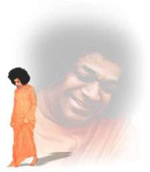|
Tuesday, Oct 14 2025
GURU PRUNIMA - 18 JUNE 2012
What is Guru Purnima? The full moon day in the Hindu month of Ashad (July-August) is observed as the auspicious day of Guru Purnima, a day sacred to the memory of the great sage Vyasa. In his memory this day is also called Vyasa Purnima. All Hindus are indebted to this ancient saint who edited the four Vedas, wrote the 18 Puranas, the Mahabharata and the Srimad Bhagavata. Vyasa even taught Dattatreya, who is regarded as the Guru of Gurus.
This leads us to our next question. Who is a Guru? Our beloved Swami says, The Guru is one who dispels the darkness of ignorance in our lives. Gu means one who is beyond attributes or gunas, Ru implies one who is beyond forms or rupas. This refers only to God. That is why the Guru is hailed as Brahma, Vishnu, or Siva. Guru is the one who reveals the Guri (target) to the disciple. Guri here refers to the Aathmic Principle.
The Hindu Shastras have hailed such Gurus immeasurably:
A famous verse known to all Hindu children that glorifies the Guru is:
Gurubrahma Guruvishnu Gururdevo Maheshwaraha |
Guruhu sakshaat Parambrahman tasmai Shrigurave namaha ||
This means that: "The Guru is Brahma, Vishnu and Shiva; and I honour the Guru who is the embodiment of God himself."
Another famous verse known to many is:
Guru Govind donu khade, kisko laagu paay, Balihari Gurudevaki jinhe Govind diyo bataay.
The first line asks: The Guru and Govind (God) are present before me, to whom shall I bow down first? The answer to the question comes in the next line which says that Glory is to the Guru since he showed Govind (God).
The great poet and philosopher Kabir observed the relation between Guru and disciple as, "Guru being the washer-man, disciple the cloth, soap the creator, washed on the stone of knowledge, which gives out utmost light brightness."
This couplet of Kabir throws light on the relation of a Guru (Master) to a disciple; who (Guru) washes away the dirt (bad element) in the mind of the disciple and thus makes him clean, pure and pious. He expects from almighty that by his blessings, he should enlighten his inner conscience.
These couplets and mantras would have given a good example of how important a Guru is. But I would like to support the fact with the example of Dronacharya from Mahabharatha. In this story Ekalavya was rejected by the royal teacher Dronacharya to teach him archery. Felling the need of a Guru for his learning, Ekalavya erected a statue of Dronacharya, observed his classes and learnt the art of archery. The panchapandavas too became legendary warriors only because of the training they received from a Guru. From this example we see that a Guru is needed in everyone's life whether their effect is direct or passive.
A question that may now arise is that these examples were of the past. Is there something more relevant to our time period? To answer this question let us take the example of respected Sir A.P.J. Abdul Kalam. In his books and many of his speeches he has said that it was because of his teacher did he gain a thirst for knowledge and a passion for learning. If it were not for his teacher we would never have heard of Abdul Kalam, Astrophysicist and ex-president of India!
Through the many excerpts and examples it is crystal clear that a Guru is of utmost importance in one's life. He is one who makes us LOVE TO LEARN and also teaches to LEARN TO LOVE!
So what do we do on Gurupurnima?
• Chant the holy Name "Sai Ram. Sai Ram. Sai Ram "
• Visit a temple this day
• Thank our Gurus for all their support
JAI SAI RAM
Bro Abhishek Srikanth
Group 4 |

